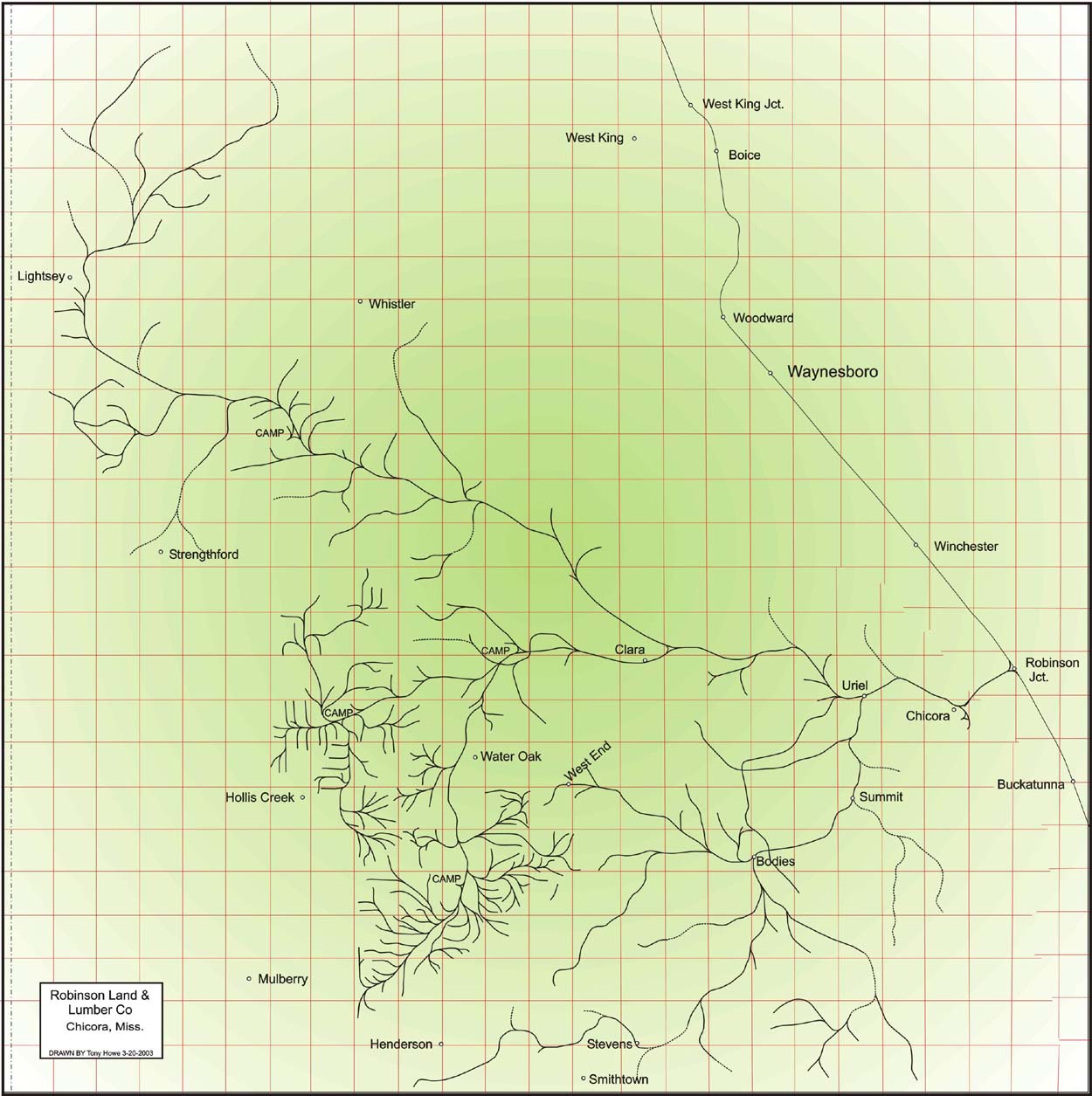
Chickasawhay & Jackson Railroad
Chicora & Northwestern Railroad
Robinson Land & Lumber Co.
|
Standard Gauge, lb. rail Headquarters: Chicora, MS Mill locations: Moss Point, MS Chicora, MS (Wayne Co.) Bothwell, MS (Greene Co.) Years of Operation: 1892-1933 Miles Operated: Locomotives Owned: |
Also see: Pascagoula Lumber Co.
|
Click Map for Larger Version |
|
George Wesley Robinson, founder of the Robinson Land & Lumber Co., was one of the early lumbermen in the South. Like many sawmill operators in Mississippi, Robinson got his start, however, in the white pine lumber industry of Michigan. He was part-owner in Tyson, Robinson & Co., a large lumber manufacturer that operated at Manistee, Michigan. He also was associated with John Canfield and the Filer City Boom Co. around 1870, and was an organizer and director of the Manistee Boom Co. in 1873. As northern timber began to play out, Robinson ventured south and purchased large tracts of timber in Baldwin County, Alabama. In 1872, he established a large sawmill at Millview, ten miles west of Pensacola, that manufactured longleaf yellow pine for the booming export trade. A 36" gauge logging railroad was built northwestward along the Styx River from Seminole, Alabama. This railroad was operated jointly with the Seminole Lumber Co., which also had a sawmill at Millview. George W. Robinson & Co. was sold to the large Southern States Land & Lumber Co. on May 17, 1889. By the 1890's, Robinson formed a partnership with Charles A. Swift (who was later involved in the large Swift-Hunter Lumber Co. at Atmore, Alabama) and built a standard gauge logging railroad along Sandy Creek in Baldwin County, Alabama. By 1899, this logging operation was also absorbed by the Southern States Lumber Co.
George Robinson’s first Mississippi operation was located at
Moss Point. On January 11, 1876, the firm of A. C. Danner & Co.
purchased a sawmill from H. C. Vaughan on the Escatawpa River east of
downtown Moss Point, near Elder’s Ferry. On July 20, 1883, A. C.
Danner & Co. purchased the holdings of the Fernland Saw Mill Co.,
which included a sawmill at Fernland, Ala., which was near Grand Bay,
and timberland northeast of Moss Point. At that time, A. C. Danner &
Company was composed of Albert C. Danner, of Mobile, George W. Robinson,
and Benjamin McMillan, both living in Baldwin Co. In late 1883, the
Danner Land & Lumber Co. moved the sawmill from Fernland to Venetia,
Ala., the name given to the point where the L&N Railroad crossed the
Dog River. The new mill was capable of cutting 40,000 feet a day when it
opened in early 1884. In addition, the sawmill at Moss Point was
estimated to cut 50,000 feet per day in 1884. A planing mill was also
operated by the company in Mobile. A. C. Danner & Co. went bankrupt,
and the mill east of Moss Point was abandoned by 1889. George W. Robinson must have found Moss Point to be an excellent location for sawmilling. On July 16, 1886, he purchased the bankrupt properties of Emile DeSmet for $65,000, which included two sawmills, planing mill, store building, wharves, machine shop, log boom and river logging equipment. To operate these properties, Robinson incorporated the Pascagoula Lumber Company, and transferred the property to the new company on July 14, 1887.
Emile DeSmet was a native of Belgium, and quickly earned the
nickname “the Saw Mill Cyclone,” as he came to Moss Point and
purchased several sawmills in the area. He bought two sawmills on the
north side of the Escatawpa River owned by William C. Diggs and the
partnership of Col. Borden and Sam Elder. DeSmet also owned a mill on an
island between the river and Jerry Morton Lake. After being rebuilt at
least twice due to fire, this mill came to be known as the “Phoenix
Mill.” The total output of the DeSmet mills in 1884 was reported to be
between 75,000 and 80,000 feet per day. DeSmet went bankrupt after
over-extending himself. His mills were first sold to A. Carriere &
Sons of New Orleans for $175,000 in early May 1884. At that time
properties consisted of 2 circular sawmills cutting 80,000 feet daily
total. The mills were kept running until they shut down for repairs in
August 1884. DeSmet died in
South America in August 1885. By this time the mills at Moss Point were
shut down and in the hands of the receivers.
Not long after he purchased the DeSmet properties, Robinson
repaired the two mills, known as the Phoenix and Elder mills, and added
to their cutting capacity. By 1888, the Pascagoula Lumber Co. had built
a pole road in northwestern Mobile County. This pole road ran eastward
from the Escatawpa River, where the logs were dumped in the river to be
floated down to the mills at Moss Point. By the early 1890's, a second
pole road was also built eastward from the Escatawpa River a few miles
north of the first pole road. At this time, the mills in Moss Point were
cutting as much as 125,000 feet per day. As most of the mills in the
Moss Point area had done for decades, logging contracts were awarded by
the Pascagoula Lumber Co. to independent loggers along the Pascagoula
and Escatawpa Rivers and their tributaries for logs to be floated down
the rivers to the company’s booms at Moss Point. In the 1890's the
company purchased timberland northeast of Plum Bluff, now located in
George County. Pascagoula Lumber Co. contracted with R. C. Luce and Son
to deliver logs to the Pascagoula River at Plum Bluff and to raft the
logs to Moss Point. R. C. Luce and Son, under the management of Gregory
M. Luce, built a standard gauge logging railroad into the Pascagoula
Lumber Co. timberlands in May 1894. In addition, Luce purchased
timberland east of Plum Bluff and hauled the timber to the river and
delivered much of it to the Pascagoula Lumber Co. Between January 1895
and June 1896, Luce delivered between 1000 and 6000 logs a week to the
Pascagoula Lumber Co. There is some evidence that Robinson supplied
railroad equipment to Luce to be used on the logging railroad running
northeast from Plum Bluff. By 1899, Luce had built a mill at the new
town of Lucedale, and later became involved in the K. C. Lumber Co. at
that location. The Pascagoula Lumber Co. was transferred to the Robinson
Land and Lumber Co. on February 20, 1897, who continued to operate the
mill at Moss Point until as late as 1912. After the Luce railroad out of
Plum Bluff was abandoned around 1902, it doesn’t appear that any
logging railroad was operated to supply the mill at Moss Point with
logs. In the early 1890's, George W. Robinson turned his attention northward, and acquired large tracts of timberland in Wayne County, Mississippi. The largest of these tracts was acquired from the Mobile and Ohio Railroad, through the Farmers Loan and Trust Co. and the Alabama Land and Development Co. An agreement was made on November 19, 1891, allowing Robinson to cut timber from certain M&O-owned lands in Wayne County totaling 66,520 acres. Robinson agreed to start construction a steam saw mill near the M&O within six months and to have the mill in operation within 12 months, and to build a railroad to log this mill within 18 months. Robinson was given twenty years to cut the timber from the M&O lands, and was to pay the M&O 50 cents per 1000 board feet of logs cut. Robinson also agreed to cut no less than ten million feet of logs within 24 months of signing the contract. He also agreed to cut no less than ten million feet of logs each year after the first 24 months. The M&O lands in this contract stretched all the way from the south edge of the county to the northwest corner of the county, and mostly consisted of only odd-numbered sections, or parts of odd-numbered sections, with some exceptions closer to the Chickasawhay River.
The site selected for the new mill was located about three miles
northwest of Buckatunna, on the west side of the Chickasawhay River. By
April 1892, work on the sawmill had started. The 100,000 foot capacity
mill was equipped with a Filer and Stowell circular saw and two gang
edgers, and was built to cut timbers in long lengths of 80 to 100 feet.
The town that grew up around the mill was named Chicora. To operate the
mill, the Robinson Land & Lumber Co. was incorporated on November
11, 1892, by George W. Robinson, of East Orange, NJ; Edward W. Robinson,
of Buckatunna; Frank G. Robinson, of Moss Point; Elver W. Manahan, of
Moss Point; and John D. Cameron, of Mobile. The new company had an
authorized capital stock of $250,000.
The M&O built a spur about a mile and a half long to the
sawmill. This spur crossed the Chickasawhay River on a steel truss
bridge. The point where it connected with the mainline was named
Robinson Junction. The owners of the Robinson Land and Lumber Co.
incorporated the Chickasawhay and Jackson Railroad on October 5, 1892,
to build the logging railroad, which was planned to run from the sawmill
on the west side of the Chickasawhay River northwesterly to a junction
with the NO&NE in Jones County near Sandersville. The railroad had
12 miles in operation by May 1894. The main business of the railroad was
mainly to haul logs from the woods to the mill at Chicora. The railroad
left the mill at Chicora and turned northwest and generally followed
Patrick Creek to the small community of Uriel. At this point the main
line turned south into timberland owned by the company and logging spurs
were built as far south as the Greene County line. In the early years
the line ran to a small town known as Stevens that was located just east
of present-day Highway 63 a couple of miles north of the county line.
Between 1893 and 1906, the company was logging the area south of Chicora
and Clara. By 1903 the line had reached a point just east of Sand Creek
above the Greene Co. line and the railroad called the end of the
railroad Henderson, even though the community by that name was actually
about two miles west of the end of the railroad. In an effort to attract
more business, the railroad was officially opened for general business
on June 1, 1905. In 1906, the main line was extended from Uriel to
Clara, where a logging camp was located. Between 1906 and 1910, the line
was gradually extended from Clara northwestward to Lightsey as logging
progressed in that direction. Around 1910 a logging camp was built near
Brushy Branch southwest of Whistler. During that year the company was
logging the area between Whistler, Strengthford, and Lightsey. From 1910
through at least 1912 the company logged the area near Big Thompson
Creek and Little Thompson Creek and between the towns of Lightsey and
Eucutta. This was the far northwestern end of the Chickasawhay &
Jackson Railroad, as the line was never completed to the planned
connection with the NO&NE.
In late October 1908, George W. Robinson died while at his home
in New York City. He also had homes at Orange, N.J., and in Mobile, Ala.
He usually spent his winters in the South looking after his business.
His son, Wesley A. Robinson, actually took over the management of the
Robinson Land and Lumber several years before his father’s death. A
major change in ownership of the company came in 1912 when three
lumbermen from Moss Point and Mobile, J. J. McIntosh, A. N. McInnis, and
W. B. Patterson, purchased a controlling interest in the Robinson Land
& Lbr. Co. John J. McIntosh was born in Canada on May 20, 1864, and moved to Mobile in 1890 and entered the lumber business with his uncle, A. J. Paterson. A year later he moved to Moss Point and took charge of the lumber export business of Paterson & Downing until 1901. In that year he formed the McIntosh Lumber Co. in association with Fritz Colmer and N. McInnis. Shortly after moving to Moss Point, McIntosh’s wife died, and he later married the daughter of S. A. McInnis. McIntosh was also director of the Merchants and Marine Bank in Moss Point until he resigned that position in 1914 to move to Chicora. Two years later he moved back to Moss Point and resumed his positions with the M&M Bank and McIntosh Lumber Co.
Alexander Nott McInnis was born in 1884, and was also a prominent
lumberman from Moss Point. He was part owner of the Native Lumber Co., a
Dantzler subsidiary at Howison, Miss. He was vice-president of a bank,
the Pascagoula National Bank, until he resigned in May 1914 to look
after his purchase of the Robinson Land & Lumber Co. In addition, he
was also interested in the McIntosh Lumber Co.
William B. Patterson was a lumberman from Mobile, Ala. He had
been a partner with George Leatherbury in the Star Lumber Co. at
Eubanks, near Lucedale, from 1901 to 1903. He was also a partner with A.
Vizard in the Daphne Logging Co. near Mobile from 1906 until 1911.
The new owners upgraded the sawmill and logging railroad. The
C&J was reorganized as the Chicora and Northwestern Railway on June
24, 1914, by Patterson, McIntosh, and James T. Ward, who was logging
superintendent for RL&L. On March 1, 1915, the railroad inaugurated
daily except Sunday passenger service between Chicora and Clara. Traffic
for the railroad continued to consist mostly of logs for the big mill of
the Robinson Land & Lumber Co. at Chicora. In a December 16, 1916,
report, the M&O stated that products interchanged with the Chicora
& Northwestern consisted of the following: “the product of 2
turpentine stills which this season amounted to 1,400 barrels rosin and
425 barrels spirits, 450 bales cotton and output of four portable
sawmills with average capacity of 8
to 10 thousand feet per day, but these mills run very irregularly; 89
car loads of dog wood for shuttle blocks.
Traffic from us consists of general merchandise to
2 stores and 1 drug store at Clara.
No coal.” Robinson Land & Lumber continuously added to its timber holdings from the late 1890's into the early 1920's. By the time the M&O timber contract expired in 1911, the company still had considerable timber holdings to cut. On November 1, 1912, the company bought 13,080.75 acres of timber from the Blodgett Co., Ltd. for $770,000. This timber was located between 3 and 10 miles west of Clara. The logging railroad running northwest from Clara to Lightsey was abandoned while the railroad was built westward from Clara into the new timber. Another 8200 acres was purchased from Blodgett for $635,160 in the mid-teens. In 1919-1920, the logging railroad was built south from a point about 4 miles west of Clara into the new timber holdings. This new line ran about a half mile west of Water Oak, and stayed within a mile of present-day Highway 63, as it was extended southward throughout the 1920's. A logging camp was set up about three miles south of Water Oak near Piney Woods Creek and Okey Branch. The area south of where Robinson Land & Lumber was logging in the 1920's was being logged by the Virgin Pine Lumber Co. of Piave and the C&R Lumber Co. of Blodgett. There is no evidence that the railroad of RL&L ever connected with either of these two railroads, but they logged lands adjacent to each other in several places. It is quite possible that a connection was made with the logging railroad of Wausau Southern Lumber Co. in the late teens near the Hollis Creek vicinity. Wausau Southern did utilize several abandoned roadbeds of Robinson Land & Lumber near Lightsey in the 1920's.
A new opportunity for the company came in the late teens as the
Gulf, Mobile and Northern Railroad was building a new branchline up
through Greene County known as the Blodgett Branch. This line opened up
the tremendous holdings of the Blodgett Co, Ltd., that were previously
isolated to sawmill development due to the distance from the nearest
railroad. In the late teens, Robinson Land & Lumber purchased
13,571.27 acres of timberland from the Blodgett Co., Ltd., in the vicinity
of the small town of Bothwell on the new branch. In May 1920, Robinson
Land & Lumber built a sawmill at Bothwell to cut this timber. This new
mill was equipped with a single band mill, and could cut 70,000 feet a
day. A standard gauge logging railroad was built east from Bothwell into
this timber, and eventually reached a length of about ten miles. A new
42-ton Shay was purchased for use at Bothwell in 1920, and a 55-ton
Baldwin 4-6-0 was transferred from Chicora about this same time. In
September 1923 the Bothwell mill, logging railroad and over 100,000,000
feet of standing yellow pine timber in Greene County were sold to the L.
A. Cowan Lumber Company, of Mobile, Alabama. Apparently this sale was
never made final, because in January 1924 the operation was back in the
hands of the Robinson Land & Lumber Company and was renamed the
Bothwell Lumber Company. In the mid-1920's, a new logging railroad was
built west from the mill at Bothwell. This line had to first cross the
GM&N at grade, and then ran southwestward into about 3000 acres of
timber owned by the company west of the GM&N. By mid-1927, a second
Baldwin ten-wheeler weighing about 45 tons was added to the roster at
Bothwell. The mill at Bothwell finally cut out in the summer of 1929.
|
||
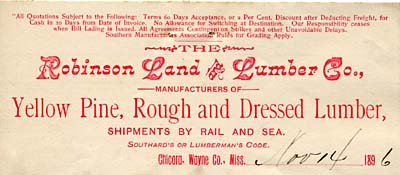
Jackson County Archives Collection |
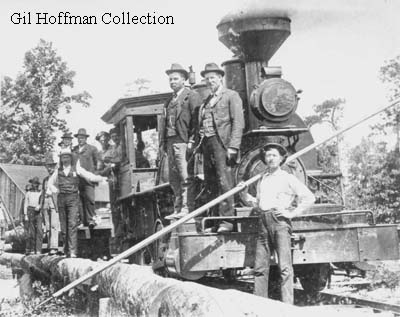
Robinson Land & Lumber's Porter 0-4-2T at Chicora circa 1895 |
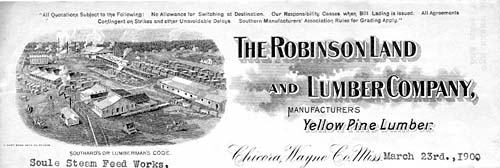
Mississippi Industrial Heritage Museum Collection |
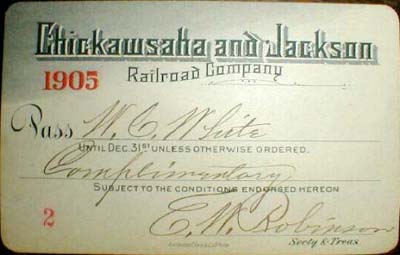 Notice spelling of Chickasawhay |
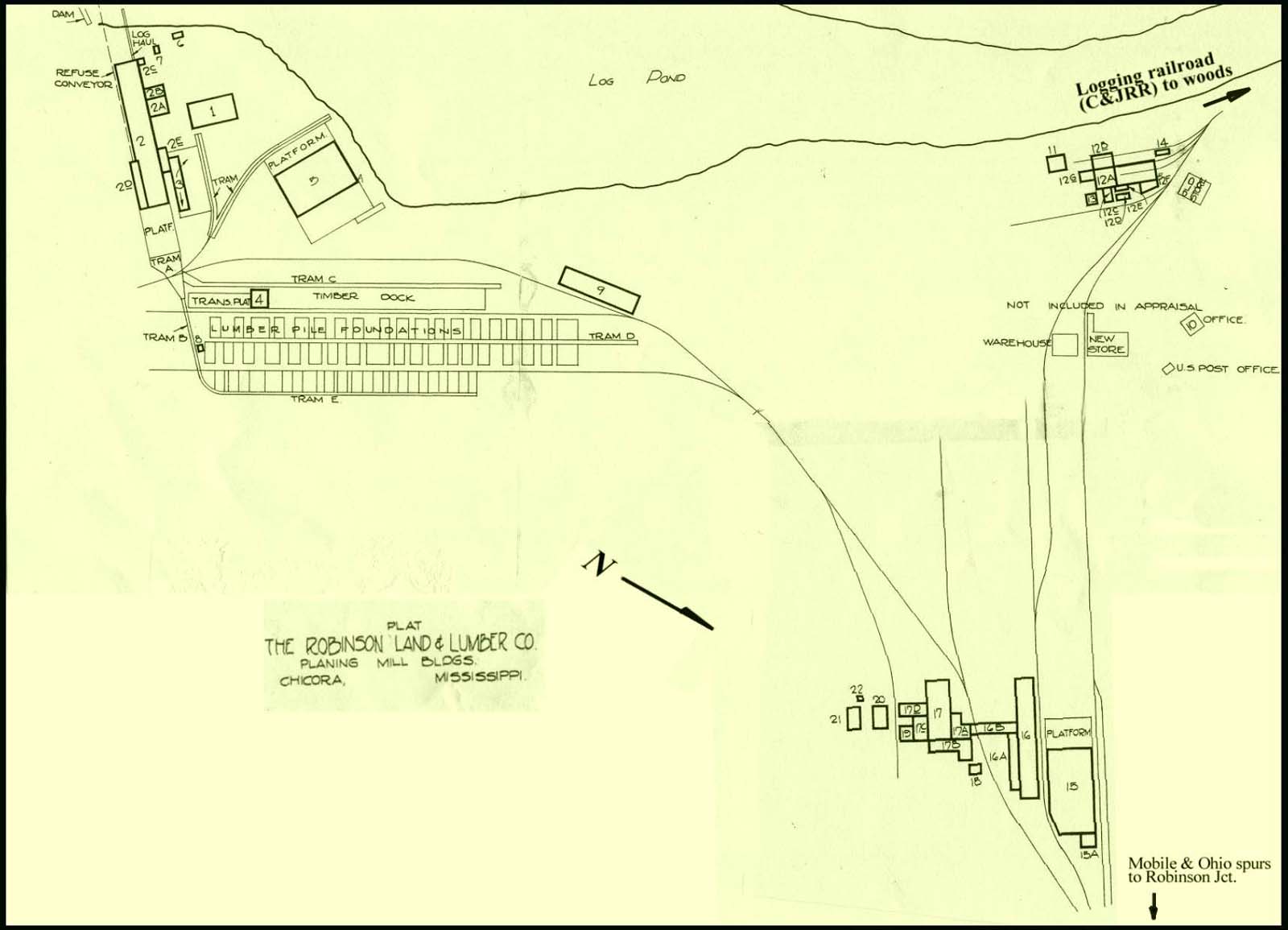
Click map for larger version |
Click map for larger version |
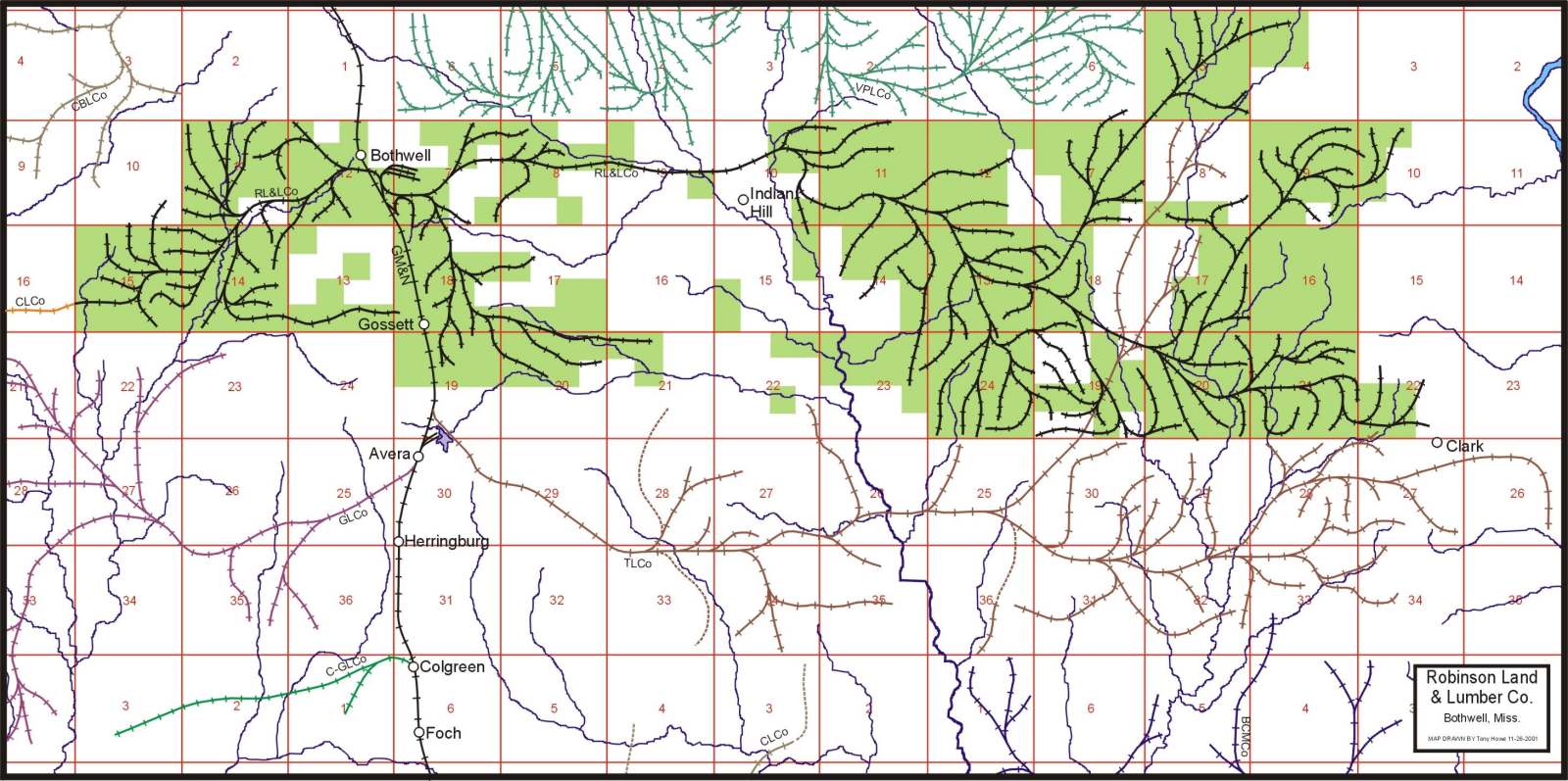
Click map for larger version |
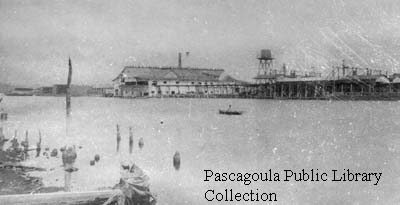
Robinson's Phoenix Mill at Moss Point in the 1890's. |
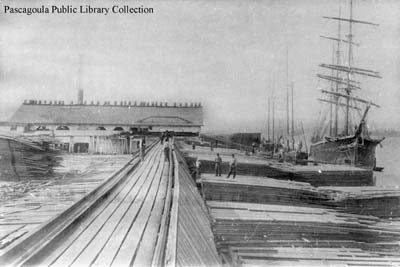
Another view of Robinson Land & Lumber Phoenix mill. |
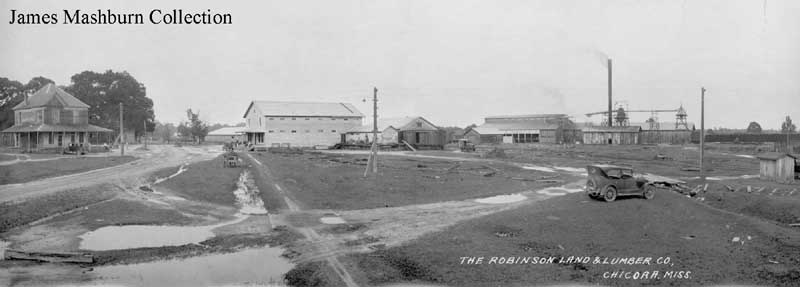
Panoramic view of Chicora shows (left to right) company office, commissary, and planing mill. |
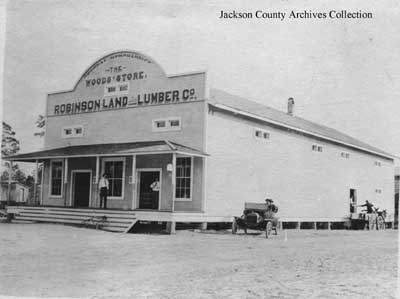
Commissary at one of Robinson Land & Lumber's camps, possibly Clara. |
|
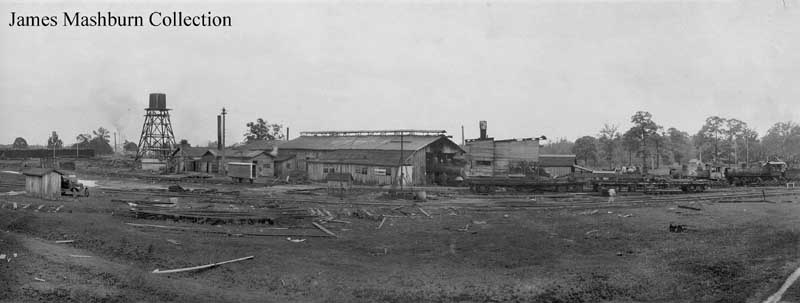
Right section of above panoramic photo shows the company's machine shop and engine house, which miraculously survived until 1994 |
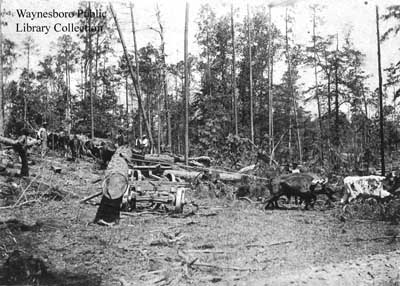
Loading Lindsey wagon using the crosshaul method with oxen. |
|
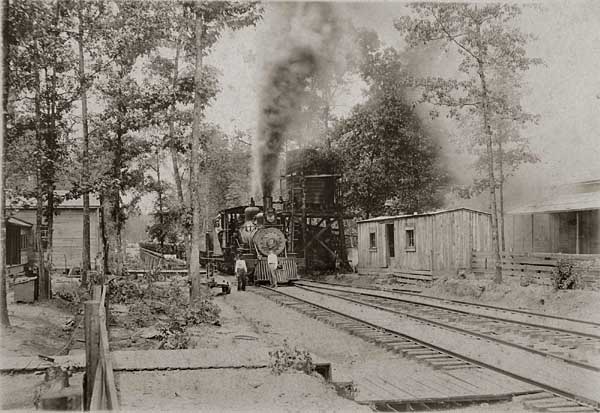
RL&L No. 2 on log train at the camp at Clara. |
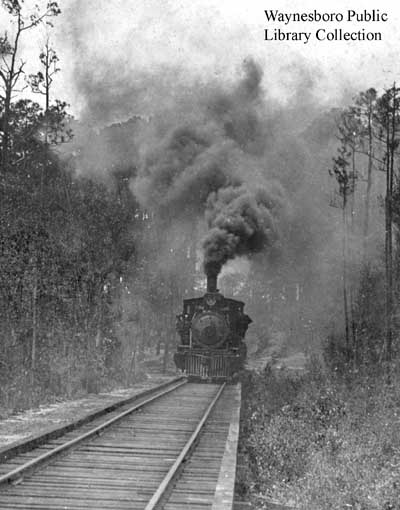 |
|

Robinson Land & Lbr camp at Clara, looking west. |
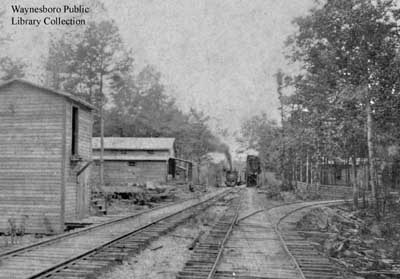
Section of photo at left. |
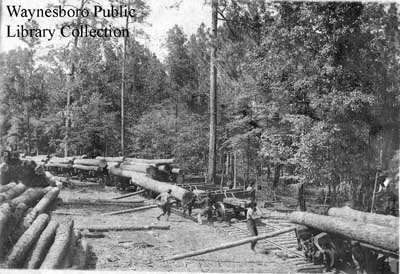
RL&L loading log cars. |
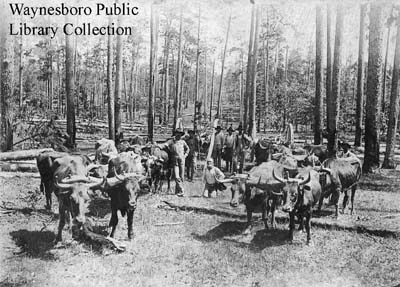 |
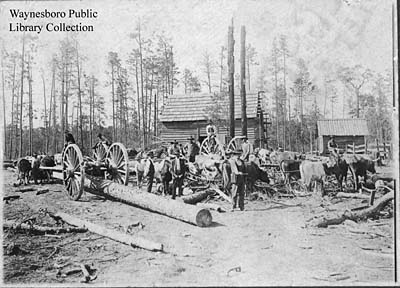 |
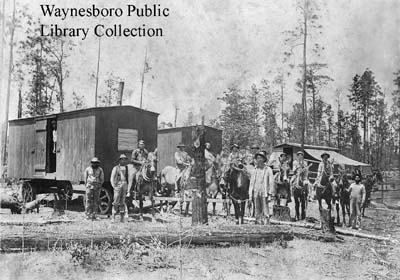 |
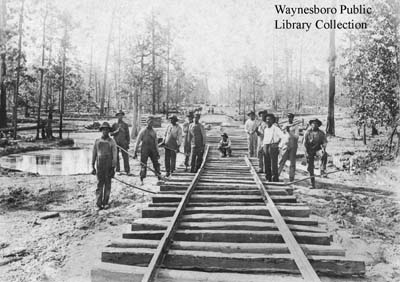
RL&L section gang building another section of logging railroad. |
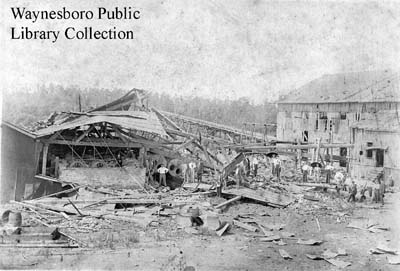
Aftermath of boiler explosion at RL&L mill at Chicora. |
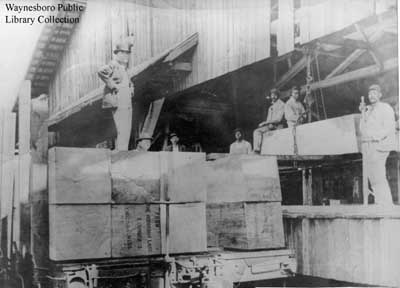
Loading large timbers at the mill at Chicora. |
 September 1903 Official Railway Equipment Register |
||
|
ROSTER (Chicora Operation) by Gil Hoffman: ?
0-4-2T
Porter
1393
7-1892
10x16
Purchased
new by George W. Robinson. To
Robinson Land & Lumber Co., in 11-1892. ?
0-4-2T
Baldwin
9182
4-1888
37
11x16
39600 Purchased
from Hieronymous Brothers, Theodore, AL. Built
as Mobile & Spring Hill R.R. #1, Mobile, Ala.; to Hieronymous
Brothers, Theodore, AL, by 3-1894. Sold
to Choctawhatchee Lumber Co., Freeport, FL, by 12-1912. Baldwin
class
6-16_
C 29 ?
0-4-4F
Baldwin
13015
11-1892
42
9&15x16
58000 Purchased
from Chicago & South Side Rapid Transit R.R. #35. Sold
to The K. C. Lumber Co. #2, Lucedale, MS, by 12-1908. Baldwin
class
8-12/24_
C 45
?
2T Shay
Lima
222
11-1888
29½
3-10x10
60000 Purchased
from Charles D. Marshall, in MS. 1
2-4-0
Baldwin
8605
6-1887
49
15x22
60000 Purchased
secondhand. On hand by
7-1905. Built
as Brooklyn, Bath & West End #1 “West Brooklyn,” Brooklyn, NY. class
6-24 C 8 3
2T Heisler
Heisler
1382
9-1918
38
15½x14
106000 Purchased
from Canal Lumber Co. #3 “Williamson,” Hintonville, MS For
sale
4-1933. Sold
to Birmingham Rail & Locomotive Co. #1808, Birmingham, AL; to Pine
Hill Coal Co. #3, Pottsville, PA, on 8-15-1935.
5
2T Shay
Lima
1772
10-1906
28
3-10x10
66000 Purchased
new. Scrapped
about 1927.
6
2T Shay
Lima
1773
11-1906
28
3-10x10
66000 Purchased
new. Scrapped
about 5-1927.
8
2-6-0
Baldwin
9203
4-1888
58
18x24
90000 Purchased
from A. C. Torbert & Co., Chicago, IL (dealer). On hand by 4-1912. Built as Chicago & Eastern Illinois R.R. #71; to A. C. Torbert & Co., in 9-1907. Baldwin
class
8-30 D 246
10
2-8-0
Baldwin
5373
11-1880
36
15x18
56000 Purchased
from Fitz-Hugh Luther Co., Chicago, IL (dealer). On hand by 3-1905. Built
as Denver & Rio Grande Ry. #81 “Puerco” (36-inch gauge); to Denver
& Rio Grande Western Ry. #81, on 7-12-1886; to Rio Grande Western Ry.
#70, in 6-1889, renumb. #14 in 1892, changed to standard gauge in 1898; to
Fitz-Hugh Luther Co., in 7-1903. Baldwin
class
10-24 E 85
101
4-6-0
Baldwin
9208
4-1888
49
19x24
110000 Purchased
from Colorado Midland Ry. #31. On hand by 2-1909. Transferred
to Bothwell, MS, same road no. Baldwin
class
10-32 D 192
225
2-6-0
Baldwin
5460
1-1881
55
18x24
78000 Purchased
secondhand. Built
as East Tennessee, Virginia & Georgia R.R. #5. Baldwin
class
8-30 D 63
|
||
For more information contact Tony Howe at howe6818@bellsouth.net or David S. Price at dsprice46@bellsouth.net
All content on Mississippi Rails website is copyrighted by us or the individual or institution noted on the image or accompanying text. Please contact us below for permission to use any image or information contained on this website. Mississippi Rails is not affiliated with any railroad.
©2009 Mississippi Rails
